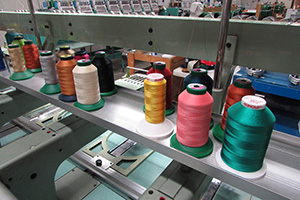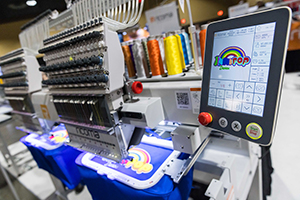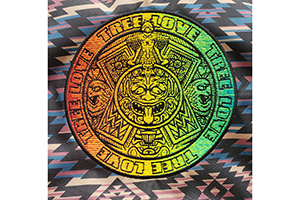March 17, 2015
As embroiderers, we experiment with all kinds of materials to create special effects. From 3-D embroidery foam to appliqué and Mylar-enhanced creations, we go all out to add glamour and interest to our embroidery.
Here, taking it back to basics, you’ll learn how using a variety of specialty embroidery threads can help create an intriguing range of effects.
BLING THREAD
Metallic is a beautiful thread type that embroiderers love to hate. Everyone loves the look of this thread, but ask a roomful of embroiderers how they like using it and you’ll get answers like, “I hate it,” or “I try not to use it.”
Metallic thread can be a pleasure to use. There are different types of metallic thread and some are friendlier than others. Still, all high-quality metallic threads can be used successfully if the correct components and techniques are used.
Traditional Metallic: This thread is composed of a polyester or nylon core wrapped with metallized foil material and other components to make it pliable and have the desired color. While metallic thread certainly is delicate, it is that which has been manufactured using inferior components or production methods that is responsible for the poor reputation shared by the entire category.
Metallic thread is susceptible to damage from friction, so it’s important to use a large-eye needle when embroidering with it. There are large-eye needles designed specifically for use with metallic thread, or you can use a specialty top-stitching needle for single-needle machines. You also can use a larger blade size to get a larger eye.
Use a lightly balanced tension setting to avoid excessive thread breakage. Reducing the tension on the top thread is recommended. You also may find it helpful to reduce the machine’s running speed.
Traditional metallic threads come in different weights or thicknesses. Lighter-weight thread is good for accents and detailed areas, while thicker metallics cover larger areas with fewer stitches.
Metallic threads typically are stiffer than standard embroidery threads, so longer stitches in running and fill-stitch areas can help the sewing process proceed more smoothly. Because it is stiffer, you may want to cover the back of your wearable metallic creations with a soft, fusible tricot product made for this purpose.
Flat Metallic: This is a unique thread type that has a metallic effect and features a flat, ribbon-like appearance with no resemblance of that which we normally associate with a fiber thread. It consists of a polyester film laminated between two pieces of colored aluminum metallic foil, coated with clear polyethelene. It has a flat, reflective surface that refracts light best on longer stitch types, such as satin stitches. Some threads in this category have a holographic effect. Generally, the same stitching techniques used for traditional metallic thread are recommended for flat metallic thread.
Brand names for this thread type include Glitter, Holoshimmer and Sliver.
BOLD THREAD
Yarn-Like: On the opposite end of the spectrum from shimmery metallic is the bold look of thicker, yarn-like threads. This thread type is invaluable for creating retro-looking embroidery that has enjoyed recent popularity, as well as folk-art embroidery. These threads usually are acrylic or wool/acrylic blends.
You can tell just by looking at this thread that it requires a large-eye embroidery needle. Density must be reduced, the amount by which depends on the desired effect. Space it widely for a true hand-stitched appearance or a bit closer for good coverage with a lighter stitch count than standard embroidery threads. Experimentation will show you the best density for your desired result. Begin by using a density setting of about nine points.
Getting the most reliable stitching with this thread may necessitate going beyond the normal lighter tension adjustment. On some machines, the hook timing may need to be slightly retarded to make the hook point come later than normal to avoid splitting the thread. Another approach is to raise the needle plate slightly by placing a spacer — such as a washer — beneath the plate. Brand names for this type of thread include Filaine, Monet and Burmilana.
Heavy Cotton: Size 30 cotton thread provides a matte-like appearance that is ideal for traditional embroidery on linens and other materials. Some companies use this thread to duplicate a hand-appliqué effect. These friendly threads require a large-eye needle; otherwise, no special stitching modifications are needed. Brand names for this thread type include Cotty and Cotona.
FINE THREAD
Just as bolder thread sizes provide better coverage for large areas, finer thread sizes help create clearer small embroidery. One of the biggest challenges faced by all embroiderers is getting good clarity on small lettering. Using a needle with a smaller blade, combined with a small thread size — like 50 or 60 — provides half of the solution.
The other half is a proper programming technique that creates bulk by using lighter density and fewer intersections.
Size 60 polyester thread has become a go-to option in the savvy embroiderer’s toolbox. Lightweight cotton thread also is available. Brand names for lightweight polyester include Fine Line and PolyLite, while others simply define it as 60-weight polyester.
THREAD THAT GLOWS
An interesting thread type is made of polyester and it stores light, emitting a faint glow-in-the-dark effect. This thread typically is size 40, so an embroiderer would use normal methods with a size 75/11 embroidery needle. Ideal products for this thread include pillowcases, bed spreads, costumes, pajamas, guest bathroom towels and more. Any designs suitable for 40-weight thread can be used, and fun ideas include lettering, planets, stars and animal eyes.
Care for a design featuring glow-in-the-dark embroidery by washing it at cool temperatures without chlorine bleach, or by dry cleaning. Brand names for glow-in-the-dark threads include Luna, Moonglow, Glowy and Fluor.
MULTICOLORED THREAD
This is another interesting category that can be surprisingly dramatic or whimsical when used effectively. Variegated threads change color at regular intervals. Some threads have varying shades of a specific color, while others are multicolored. For example, variegated threads may change from pink to dark pink to red repetitively. Multicolored thread, however, may change from blue to red to purple.
Variegated and multicolored threads are used most effectively in running or satin stitches. I particularly like to use them in large satin-stitched personalizations. When using variegated thread in a satin-stitched element, it may be helpful to pull the thread to get to the same color before resuming stitching to maintain even spacing between the colored sections.
TWIST THREAD
Variegated or multicolored threads can look a bit unnatural in fill-stitched areas. A better choice of specialty thread for this stitch type is twist thread. With this thread type, two different colors are twisted together to form a subtle or dramatic effect. Two similar shades with only a slight variation in color can be used effectively for floral embroidery.
When first introduced, twist thread was popular for animals — one well-known color was even called Teddy Bear Brown. I like to use twist thread in gray or tan for courthouses and other embroidered historic buildings.
Embroidery thread usually is dyed and then twisted. Because twist thread must go
through this process, it sometimes is rated at a slightly heavier 35 weight. Others are rated at the standard 40 weight. Both polyester and rayon fiber types are available.
Regardless what kind of embroidery you do, chances are good that one of these specialty threads will add interest and variety to your work.
Deborah Jones is a commercial and home embroiderer with more than 30 years experience in the computerized embroidery field. She runs myembroiderymentor.com and regularly speaks at the Imprinted Sportswear Shows (ISS). For more information or to comment on this article, email Deborah at djones@myembroiderymentor.com.
Hear Deborah speak on embroidery topics at the 2015 Imprinted Sportswear Shows (ISS). Individual seminars are just $25 if you pre-register: issshows.com.
Suggested Reading
Like this article? Read these and other embroidery articles at impressionsmag.com:
• “Made in the USA: A Case Study Part I”
• “Made in the USA: A Case Study Part II”
• “How to Choose the Correct Bobbin Type”
July 28, 2023 | Design + Digitizing
Very few things in life stand the test of time. As natural as the ebb and flow of evolution, most seemingly universal customs are founded and practiced with vigor, only to fade away with a whisper as the years tick by.
FULL STORY
August 16, 2022 | Design + Digitizing
With this month’s On Design, we travel deep into the jungles of Central Mexico, harkening back to an ancient time where the Aztecs roamed the earth whilst building a formidable empire.
FULL STORY




